国际经济学第8版第五章标准贸易模型中文答案
克鲁格曼《国际经济学》第八版课后答案(英文)-Ch05
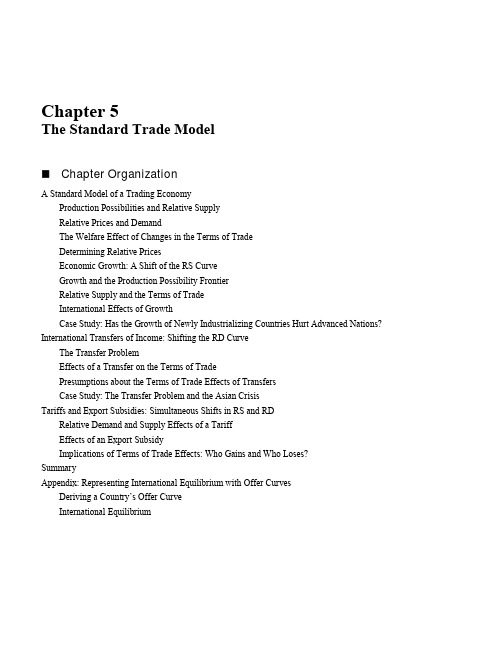
Chapter 5The Standard Trade ModelChapter OrganizationA Standard Model of a Trading EconomyProduction Possibilities and Relative SupplyRelative Prices and DemandThe Welfare Effect of Changes in the Terms of TradeDetermining Relative PricesEconomic Growth: A Shift of the RS CurveGrowth and the Production Possibility FrontierRelative Supply and the Terms of TradeInternational Effects of GrowthCase Study: Has the Growth of Newly Industrializing Countries Hurt Advanced Nations? International Transfers of Income: Shifting the RD CurveThe Transfer ProblemEffects of a Transfer on the Terms of TradePresumptions about the Terms of Trade Effects of TransfersCase Study: The Transfer Problem and the Asian CrisisTariffs and Export Subsidies: Simultaneous Shifts in RS and RDRelative Demand and Supply Effects of a TariffEffects of an Export SubsidyImplications of Terms of Trade Effects: Who Gains and Who Loses?SummaryAppendix: Representing International Equilibrium with Offer CurvesDeriving a Country’s Offer CurveInternational EquilibriumChapter 5 The Standard Trade Model 17Chapter OverviewPrevious chapters have highlighted specific sources of comparative advantage which give rise to international trade. This chapter presents a general model which admits previous models as special cases. This “standard trade model” is the workhorse of international trade theory and can be used to address a wide range of issues. Some of these issues, such as the welfare and distributional effects of economic growth, transfers between nations, and tariffs and subsidies on traded goods are considered in this chapter. The standard trade model is based upon four relationships. First, an economy will produce at the point where the production possibilities curve is tangent to the relative price line (called the isovalue line). Second, indifference curves describe the tastes of an economy, and the consumption point for that economy is found at the tangency of the budget line and the highest indifference curve. These two relationships yield the familiar general equilibrium trade diagram for a small economy (one which takes as given the terms of trade), where the consumption point and production point are the tangencies of the isovalue line with the highest indifference curve and the production possibilities frontier, respectively.You may want to work with this standard diagram to demonstrate a number of basic points. First, an autarkic economy must produce what it consumes, which determines the equilibrium price ratio; and second, opening an economy to trade shifts the price ratio line and unambiguously increases welfare. Third, an improvement in the terms of trade increases welfare in the economy. Fourth, it is straightforward to move from a small country analysis to a two country analysis by introducing a structure of world relative demand and supply curves which determine relative prices.These relationships can be used in conjunction with the Rybczynski and the Stolper-Samuelson Theorems from the previous chapter to address a range of issues. For example, you can consider whether the dramatic economic growth of countries like Japan and Korea has helped or hurt the United States as a whole, and also identify the classes of individuals within the United States who have been hurt by the particular growth biases of these countries. In teaching these points, it might be interesting and useful to relate them to current events. For example, you can lead a class discussion of the implications for the United States of the provision of forms of technical and economic assistance to the emerging economies around the world or the ways in which a world recession can lead to a fall in demand for U.S. export goods.The example provided in the text considers the popular arguments in the media that growth in Japan or Korea hurts the United States. The analysis presented in this chapter demonstrates that the bias of growth is important in determining welfare effects rather than the country in which growth occurs. The existence of biased growth, and the possibility of immiserizing growth is discussed. The Relative Supply (RS) and Relative Demand (RD) curves illustrate the effect of biased growth on the terms of trade. The new terms of trade line can be used with the general equilibrium analysis to find the welfare effects of growth. A general principle which emerges is that a country which experiences export-biased growth will have a deterioration in its terms of trade, while a country which experiences import-biased growth has an improvement in its terms of trade. A case study points out that growth in the rest of the world has made other countries more like the United States. This import-biased growth has worsened the terms of trade for the United States. The second issue addressed in the context of the standard trade model is the effect of international transfers. The salient point here is the direction, if any, in which the relative demand curve shifts in response to the redistribution of income from a transfer. A transfer worsens the donor’s ter ms of trade if it has a higher marginal propensity to consume its export good than the recipient. The presence of non-traded goods tends to reinforce the deterioration of terms of trade for the donor country. The case study attendant to this issue involves the deterioration of many Asian countries’ terms of trade due to the large capital withdrawals at the end of the 1990s.18 Krugman/Obstfeld •International Economics: Theory and Policy, Eighth EditionThe third area to which the standard trade model is applied are the effects of tariffs and export subsidies on welfare and terms of trade. The analysis proceeds by recognizing that tariffs or subsidies shift both the relative supply and relative demand curves. A tariff on imports improves the terms of trade, expressed in external prices, while a subsidy on exports worsens terms of trade. The size of the effect depends upon the size of the country in the world. Tariffs and subsidies also impose distortionary costs upon the economy. Thus, if a country is large enough, there may be an optimum, non-zero tariff. Export subsidies, however, only impose costs upon an economy. Intranationally, tariffs aid import-competing sectors and hurt export sectors while subsidies have the opposite effect. An appendix presents offer curve diagrams and explains this mode of analysis.Answers to Textbook Problems1.Note how welfare in both countries increases as the two countries move from productionpatterns governed by domestic prices (dashed line) to production patterns governed by worldprices (straight line).2.3. An increase in the terms of trade increases welfare when the PPF is right-angled. The production pointis the corner of the PPF. The consumption point is the tangency of the relative price line and the highest indifference curve. An improvement in the terms of trade rotates the relative price line about its intercept with the PPF rectangle (since there is no substitution of immobile factors, the production point stays fixed). The economy can then reach a higher indifference curve. Intuitively, although there is no supply response, the economy receives more for the exports it supplies and pays less for the imports it purchases.Chapter 5 The Standard Trade Model 19 4. The difference from the standard diagram is that the indifference curves are right angles rather thansmooth curves. Here, a terms of trade increase enables an economy to move to a higher indifference curve. The income expansion path for this economy is a ray from the origin. A terms of tradeimprovement moves the consumption point further out along the ray.5. The terms of trade of Japan, a manufactures (M) exporter and a raw materials (R) importer, is the worldrelative price of manufactures in terms of raw materials (p M/p R). The terms of trade change can be determined by the shifts in the world relative supply and demand (manufactures relative to raw materials) curves. Note that in the following answers, world relative supply (RS) and relative demand (RD) are always M relative to R. We consider all countries to be large, such that changes affect the world relative price.a. Oil supply disruption from the Middle East decreases the supply of raw materials, which increasesthe world relative supply. The world relative supply curve shifts out, decreasing the world relative price of manufactured goods and deteriorating Japan’s terms of t rade.b. Korea’s increased automobile production increases the supply of manufactures, which increasesthe world RS. The world relative supply curve shifts out, decreasing the world relative price ofmanufactured goods and deteriorating Japan’s terms of tr ade.c. U.S. development of a substitute for fossil fuel decreases the demand for raw materials. Thisincreases world RD, and the world relative demand curve shifts out, increasing the world relative price of manufactured goods and improving Japan’s terms of trade. This occurs even if no fusion reactors are installed in Japan since world demand for raw materials falls.d. A harvest failure in Russia decreases the supply of raw materials, which increases the world RS.The world relative supply curve shifts o ut. Also, Russia’s demand for manufactures decreases,which reduces world demand so that the world relative demand curve shifts in. These forcesdecrease the world relative price of manufactured goods and deteriorate Japan’s terms of trade.e. A reduction in Japan’s tariff on raw materials will raise its internal relative price of manufactures.This price change will increase Japan’s RS and decrease Japan’s RD, which increases the worldRS and decreases the world RD (i.e., world RS shifts out and world RD shifts in). The worldrelative price of manufactures declines and Japan’s terms of trade deteriorate.6. The declining price of services relative to manufactured goods shifts the isovalue line clockwise sothat relatively fewer services and more manufactured goods are produced in the United States, thus reducing U.S. welfare.20 Krugman/Obstfeld •International Economics: Theory and Policy, Eighth Edition7. These results acknowledge the biased growth which occurs when there is an increase in one factor ofproduction. An increase in the capital stock of either country favors production of Good X, while an increase in the labor supply favors production of Good Y. Also, recognize the Heckscher-Ohlin result that an economy will export that good which uses intensively the factor which that economy has in relative abundance. Country A exports Good X to Country B and imports Good Y from Country B.The possibility of immiserizing growth makes the welfare effects of a terms of trade improvement due to export-biased growth ambiguous. Import-biased growth unambiguously improves welfare for the growing country.a. A’s terms of trade worsen, A’s welfare may increase or, less likely, decrease, and B’s welfareincreases.b. A’s terms of trade improve, A’s welfare increases and B’s welfare decreases.c. B’s terms of trade improve, B’s welfare increases and A’s welfare decreases.d. B’s terms of trade worsen, B’s welfare may increase or, less likely, decrease, and A’s welfareincreases.8. Immiserizing growth occurs when the welfare deteriorating effects of a worsening in an economy’sterms of trade swamp the welfare improving effects of growth. For this to occur, an economy must undergo very biased growth, and the economy must be a large enough actor in the world economy such that its actions spill over to adversely alter the terms of trade to a large degree. This combination of events is unlikely to occur in practice.9. India opening should be good for the U.S. if it reduces the relative price of goods that China sends tothe U.S. and hence increases the relative price of goods that the U.S. exports. Obviously, any sector in the U.S. hurt by trade with China would be hurt again by India, but on net, the U.S. wins. Note that here we are making different assumptions about what India produces and what is tradable than we are in Question #6. Here we are assuming India exports products the U.S. currently imports and China currently exports. China will lose by having the relative price of its export good driven down by the increased production in India.10. Aid which must be spent on exports increases the demand for those export goods and raises their pricerelative to other goods. There will be a terms of trade deterioration for the recipient country. This can be viewed as a polar case of the effect of a transfer on the terms of trade. Here, the marginal propensity to consume the export good by the recipient country is 1. The donor benefits from a terms of trade improvement. As with immiserizing growth, it is theoretically possible that a transfer actuallyworsens the welfare of the recipient.11. When a country subsidizes its exports, the world relative supply and relative demand schedules shiftsuch that the terms of trade for the country worsen. A countervailing import tariff in a second country exacerbates this effect, moving the terms of trade even further against the first country. The firstcountry is worse off both because of the deterioration of the terms of trade and the distortionsintroduced by the new internal relative prices. The second country definitely gains from the firstcountry’s export su bsidy, and may gain further from its own tariff. If the second country retaliated with an export subsidy, then this would offset the initial improvement in the terms of trade; the“retaliatory” export subsidy definitely helps the first country and hurts th e second.。
国际经济学 第五章 标准贸易模型
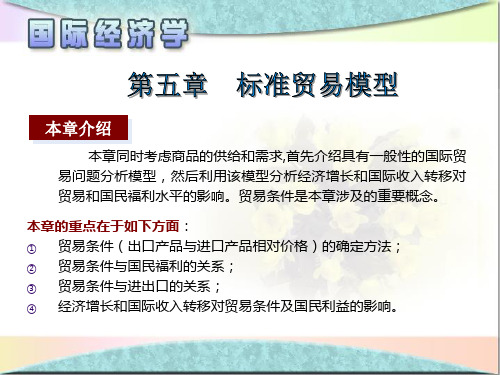
根据相对供给和相对需 求确定均衡相对价格(贸易 条件)。
PA/PB
RD’ RD
RS RS’
相对供给上升→贸易条 件恶化;
相对需求上升→贸易条 件改善。
(PA/PB)E
E” E
E’
(QA+Q*A) (QB+Q*B)
利利用用提提供供曲曲线线分分析析贸贸易易条条件件
➢ 相对价格变化,生产和需求改变,生产与需求之间差别通过贸易弥补。 如图所示,在原有的价格下,出口量为EF,进口量为CF;出口价格上 升后,出口量为E’F’,进口量为C’F’。
QB)之间的替代关系用生产可能性曲线表示。根据企业追求利润最大
化的原则,生产选择在生产可能性曲线上切线斜率的绝对值等于商品
相对价格(PA/PB)之处。(此时,在给定价格下,国内生产的名义总 产值也达到最大,请思考理由?)。QB
➢ A商品相对价格上升 →生产由点E转变为点E’ →A商品相对供给增加。
QB/Q
➢ 但如果对受援国提出必须采购本国产品的要求,本国对外国的援助所 引起的贸易条件恶化效应可以减少。
大国的关税和出口补贴同时影响供给和需求,对贸易条件形成影响。 关关税税
本国对进口产品征收关税→国内进口商品国内价格上升→进口商品相对供 给增加、相对需求减少→进口商品世界相对价格下降→本国贸易条件改善→ 有利于增加本国福利。
③ 出口产品相对价格较低时,提供曲线凸向出口商品
出口产品相对价格上升后, 一方面,在生产上,由于出口商品生产增加,增加生 产单位出口商品的成本上升, 进口商品国内生产的边际成本下降;另一方面, 在 需求上, 进口商品对于出口商品的边际替代率减少。 因此, 随着出口的增加,单 位出口要求交换的进口商品数量增加。
国际经济学第8版习题库
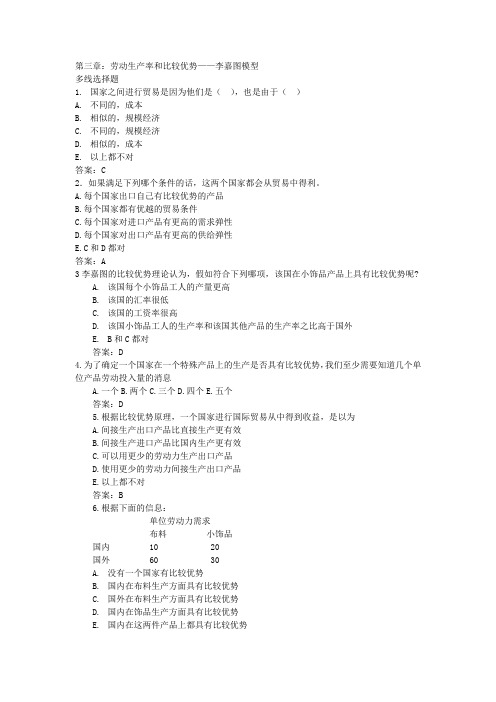
第三章:劳动生产率和比较优势——李嘉图模型多线选择题1.国家之间进行贸易是因为他们是(),也是由于()A.不同的,成本B.相似的,规模经济C.不同的,规模经济D.相似的,成本E.以上都不对答案:C2.如果满足下列哪个条件的话,这两个国家都会从贸易中得利。
A.每个国家出口自己有比较优势的产品B.每个国家都有优越的贸易条件C.每个国家对进口产品有更高的需求弹性D.每个国家对出口产品有更高的供给弹性E.C和D都对答案:A3李嘉图的比较优势理论认为,假如符合下列哪项,该国在小饰品产品上具有比较优势呢?A.该国每个小饰品工人的产量更高B.该国的汇率很低C.该国的工资率很高D.该国小饰品工人的生产率和该国其他产品的生产率之比高于国外E.B和C都对答案:D4.为了确定一个国家在一个特殊产品上的生产是否具有比较优势,我们至少需要知道几个单位产品劳动投入量的消息A.一个B.两个C.三个D.四个E.五个答案:D5.根据比较优势原理,一个国家进行国际贸易从中得到收益,是以为A.间接生产出口产品比直接生产更有效B.间接生产进口产品比国内生产更有效C.可以用更少的劳动力生产出口产品D.使用更少的劳动力间接生产出口产品E.以上都不对答案:B6.根据下面的信息:单位劳动力需求布料小饰品国内 10 20国外 60 30A.没有一个国家有比较优势B.国内在布料生产方面具有比较优势C.国外在布料生产方面具有比较优势D.国内在饰品生产方面具有比较优势E.国内在这两件产品上都具有比较优势答案:B7.假如国外使用犯人生产出口产品,那么国内应该A.出口布料B.出口小饰品C.两种产品都出口,而不进口D.不从事任何进口和出口E.上面都对答案:A8.假如国内经济遭受了大萧条,每种产品的单位劳动需求翻了四倍。
那么国内应该A.出口布料B.出口小饰品C.出口布料,不进口D.不做任何出口或进口E.以上都正确答案:A9.假如国内工资水平翻倍了,那么国内应该A.出口布料B.出口小饰品C.出口布料,不进口D.不做任何出口和进口E.以上都正确答案:A10.根据下面的信息一个单位劳动力生产的数量布料小饰品国内 10 20国外 60 30A.没有一个国家有比较优势国内在布料生产上有比较优势B.国外在布料生产上有比较优势国外在饰品生产上有比较优势C.国内在两种产品上都有比较优势答案:C11.假如国外使用犯人生产出口产品,国外生产布料的机会成本是小饰品的生产,那么国内应该A.出口布料B.出口小饰品C.两种产品都出口,不进口D.不进口,也不出口E.以上都正确答案:B12.假如国内工资翻倍了,国内应该A.出口布料B.出口小饰品C.两种产品都出口,不进口D.不出口也不进口E.以上都对答案:B14.假设只有两个国家进行贸易,这两个国家只生产两种产品,那么国际贸易会使什么增加A.假如两种产品的产量都增加了,消费者福利才会增加B.两种产品的生产量和两个国家的消费者福利都会增加C.两种产品的生产量都增加了,但不是两个国家的消费者福利都增加D.两个国家的消费者福利增加了,但不是两种产品的总生产量都增加了E.以上都不正确答案:B15.根据李嘉图模型,贸易的结果会带来哪个趋于专业化A.16.根据李嘉图模型,参加贸易的国家会发现他的消费束A.在生产边界线内部B.在生产边界线上C.在生产边界线外部D.在他贸易国生产边界线内部E.在他贸易国生产边界线上答案:C17.在李嘉图模型中,假如一个国家的贸易受到限制,下列哪项不会发生?A.有限的专业化和劳动分工B.贸易额和贸易所得都减少C.使国家在生产边界线内部进行生产D.可能导致一个国家生产一些不具有比较优势的产品E.以上都不是答案:C18.根据李嘉图模型,假如一个很小的国家和一个非常大的国家进行贸易,那么A.小国家的经济福利会下降B.大国际的经济福利会下降C.小国家将从贸易中获利D.大国家将从贸易中获利E.以上都不正确答案:C19.假如一个国家的世界相对价格在H国和F国的国内生产成本比率之间,那么A.H国将从贸易中获利,而不是F国B. F国和H国都将从贸易中获利C.H国和F国都不能从贸易中获利D.只有进行出口补贴的国家能从贸易中获利E.以上都不对答案:B20.假如F国的国内两种商品的相对价格等于世界贸易条件,那么A.H国将从贸易中获利,F国不能B.H国和F国都从贸易中获利C.H国和F国都不能从贸易中获利D.只有政府补贴出口的国家获利E.以上都不正确答案:A21.假如H国的国内两种商品的相对价格等于世界贸易条件,那么A.H国将从贸易中获利,F国不能B.H国和F国都从贸易中获利C.H国和F国都不能从贸易中获利D.只有政府补贴出口的国家获利E.以上都不正确答案:E22.假如生产可能性曲线凹向原点,那么下列哪种情况会进行生产A.机会成本不变B.机会成本递增C.机会成本递减D.机会成本无限E.以上都不正确答案:B23.假如两个国家有相同的生产可能性曲线,那么在下列哪种情况下他们之间的贸易不可能发生A.他们的供给曲线相同B.他们的成本函数相同C.他们的需求函数相同D.他们的收入相同E.以上都不正确答案:C24.比较优势原理最早是谁提出的?A.大卫。
克鲁格曼国际经济学第八版上册课后答案
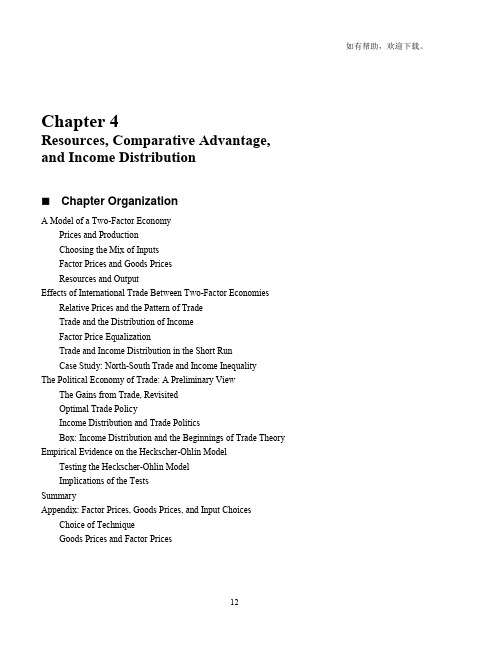
Chapter 4Resources, Comparative Advantage, and Income DistributionChapter OrganizationA Model of a Two-Factor EconomyPrices and ProductionChoosing the Mix of InputsFactor Prices and Goods PricesResources and OutputEffects of International Trade Between Two-Factor Economies Relative Prices and the Pattern of TradeTrade and the Distribution of IncomeFactor Price EqualizationTrade and Income Distribution in the Short RunCase Study: North-South Trade and Income InequalityThe Political Economy of Trade: A Preliminary ViewThe Gains from Trade, RevisitedOptimal Trade PolicyIncome Distribution and Trade PoliticsBox: Income Distribution and the Beginnings of Trade Theory Empirical Evidence on the Heckscher-Ohlin ModelTesting the Heckscher-Ohlin ModelImplications of the TestsSummaryAppendix: Factor Prices, Goods Prices, and Input Choices Choice of TechniqueGoods Prices and Factor PricesChapter OverviewIn Chapter 3, trade between nations was motivated by differences internationally in the relative productivity of workers when producing a range of products. In Chapter 4, this analysis goes a step further by introducing the Heckscher-Ohlin theory.The Heckscher-Ohlin theory considers the pattern of production and trade which will arise when countries have different endowments of factors of production, such as labor, capital, and land. The basic point is that countries tend to export goods that are intensive in the factors with which they are abundantly supplied. Trade has strong effects on the relative earnings of resources, and tends to lead to equalization across countries of prices of the factors of production. These theoretical results and related empirical findings are presented in this chapter.The chapter begins by developing a general equilibrium model of an economy with two goods which are each produced using two factors according to fixed coefficient production functions. The assumption of fixed coefficient production functions provides an unambiguous ranking of goods in terms of factor intensities. (The appendix develops the model when the production functions have variable coefficients.) Two important results are derived using this model. The first is known as the Rybczynski effect. Increasing the relative supply of one factor, holding relative goods prices constant, leads to a biased expansion of production possibilities favoring the relative supply of the good which uses that factor intensively.The second key result is known as the Stolper-Samuelson effect. Increasing the relative price of a good, holding factor supplies constant, increases the return to the factor used intensively in the production of that good by more than the price increase, while lowering the return to the other factor. This result has important income distribution implications.It can be quite instructive to think of the effects of demographic/labor force changes on the supply of different products. For example, how might the pattern of production during the productive years of the “Baby Boom” generation differ from the pattern of production for post Baby Boom generations? What does this imply for returns to factors and relative price behavior?The central message concerning trade patterns of the Heckscher-Ohlin theory is that countries tend to export goods whose production is intensive in factors with which they are relatively abundantly endowed. This is demonstrated by showing that, using the relative supply and relative demand analysis, the country relatively abundantly endowed with a certain factor will produce that factor more cheaply than the other country. International trade leads to a convergence of goods prices. Thus, the results from the Stolper-Samuelson effect demonstrate that owners of a country’s abundant factors gain from trade, but ownersof a country’s scarce factors lose. The extension of this result is the important Factor Price Equalization Theorem, which states that trade in (and thus price equalization of) goods leads to an equalization in the rewards to factors across countries. The political implications of factor price equalization should be interesting to students.The chapter also introduces some political economy considerations. First, it briefly notes that many of the results regarding trade and income distribution assume full and swift adjustment in the economy. In the short run, though, labor and capital that are currently in a particular industry may have sector-specific skills or knowledge and are being forced to move to another sector, and this involves costs. Thus, even if a shift in relative prices were to improve the lot of labor, for those laborers who must change jobs, there is a short run cost.The core of the political economy discussion focuses on the fact that when opening to trade, some may benefit and some may lose, but the expansion of economic opportunity should allow society to redistribute some of the gains towards those who lose, making sure everyone benefits on net. In practice, though, those who lose are often more concentrated and hence have more incentive to try to affect policy. Thus, trade policy is not always welfare maximizing, but may simply reflect the preferences of the loudest and best organized in society.Empirical results concerning the Heckscher-Ohlin theory, beginning with the Leontief paradox and extending to current research, do not support its predictions concerning resource endowments explaining overall patterns of trade, though some patterns do match the broad outlines of its theory (e.g., theUnited States imports more low-skill products from Bangladesh and more high-skill products from Germany). This observation has motivated many economists to consider motives for trade between nations that are not exclusively based on differences across countries. These concepts will be exploredin later chapters. Despite these shortcomings, important and relevant results concerning income distribution are obtained from the Heckscher-Ohlin theory.Answers to Textbook Problems1. The definition of cattle growing as land intensive depends on the ratio of land to labor used inproduction, not on the ratio of land or labor to output. The ratio of land to labor in cattle exceeds the ratio in wheat in the United States, implying cattle is land intensive in the United States. Cattle is land intensive in other countries as well if the ratio of land to labor in cattle production exceeds the ratio in wheat production in that country. Comparisons between another country and the United States is less relevant for this purpose.2. a. The box diagram has 600 as the length of two sides (representing labor) and 60 as the lengthof the other two sides (representing land). There will be a ray from each of the two cornersrepresenting the origins. To find the slopes of these rays we use the information from the questionconcerning the ratios of the production coefficients. The question states that a LC/a TC= 20 anda LF/a TF= 5.Since a LC/a TC= (L C/Q C)/(T C/Q C) =L C/T C we have L C= 20T C. Using the same reasoning,a LF/a TF= (L F/Q F)/(T F/Q F) =L F/T F and since this ratio equals 5, we have L F= 5T F. We cansolve this algebraically since L=L C+ L F= 600 and T=T C+ T F= 60.The solution is L C= 400, T C= 20, L F= 200 and T F= 40.b. The dimensions of the box change with each increase in available labor, but the slopes of the raysfrom the origins remain the same. The solutions in the different cases are as follows.L= 800: T C= 33.33, L C= 666.67, T F= 26.67, L F= 133.33L= 1000: T C= 46.67, L C= 933.33, T F= 13.33, L F= 66.67L= 1200: T C= 60, L C= 1200, T F= 0, L F= 0. (complete specialization).c. At constant factor prices, some labor would be unused, so factor prices would have to change, orthere would be unemployment.3. This question is similar to an issue discussed in Chapter 3. What matters is not the absolute abundanceof factors, but their relative abundance. Poor countries have an abundance of labor relative to capital when compared to more developed countries.4. In the Ricardian model, labor gains from trade through an increase in its purchasing power. Thisresult does not support labor union demands for limits on imports from less affluent countries. The Heckscher-Ohlin model directly addresses distribution by considering the effects of trade on theowners of factors of production. In the context of this model, unskilled U.S. labor loses fromtrade since this group represents the relatively scarce factors in this country. The results from theHeckscher-Ohlin model support labor union demands for import limits. In the short run, certainunskilled unions may gain or lose from trade depending on in which sector they work, but in theory, in the longer run, the conclusions of the Heckscher-Ohlin model will dominate.5. Specific programmers may face wage cuts due to the competition from India, but this is not inconsistentwith skilled labor wages rising. By making programming more efficient in general, this development may have increased wages for others in the software industry or lowered the prices of the goodsoverall. In the short run, though, it has clearly hurt those with sector specific skills who will facetransition costs. There are many reasons to not block the imports of computer programming services (or outsourcing of these jobs). First, by allowing programming to be done more cheaply, it expands the production possibilities frontier of the U.S., making the entire country better off on average.Necessary redistribution can be done, but we should not stop trade which is making the nation as a whole better off. In addition, no one trade policy action exists in a vacuum, and if the U.S. blocked the programming imports, it could lead to broader trade restrictions in other countries.6. The factor proportions theory states that countries export those goods whose production is intensivein factors with which they are abundantly endowed. One would expect the United States, whichhas a high capital/labor ratio relative to the rest of the world, to export capital-intensive goods if the Heckscher-Ohlin theory holds. Leontief found that the United States exported labor-intensive goods.Bowen, Leamer and Sveikauskas found for the world as a whole the correlation between factorendowment and trade patterns to be tenuous. The data do not support the predictions of the theory that countries’ e xports and imports reflect the relative endowments of factors.7. If the efficiency of the factors of production differs internationally, the lessons of the Heckscher-Ohlin theory would be applied to “effective factors” which adjust for the differences in technology or worker skills or land quality (for example). The adjusted model has been found to be moresuccessful than the unadjusted model at explaining the pattern of trade between countries. Factor-price equalization concepts would apply to the effective factors. A worker with more skills or in a country with better technology could be considered to be equal to two workers in another country. Thus, the single person would be two effective units of labor. Thus, the one high-skilled workercould earn twice what lower-skilled workers do, and the price of one effective unit of labor would still be equalized.。
国际经济学第八版课后答案

国际经济学第八版课后答案国际经济学是当代世界上重要的一门学科,在全球经济不断发展的今天,在不同国家和地区间进行国际贸易和投资已成为一种常态,而这种现象的背后,正是国际经济学的基础理论支撑,因此学习国际经济学的重要性日益凸显。
而对于国际经济学这门学科来说,了解、掌握相关的知识点和要点,完成课后习题,是非常重要的。
国际经济学第八版通过对国际贸易、投资、汇率、国际收支等一系列问题进行系统讲述,对学生进行全方位的培养,涉及到的知识点也十分广泛,因此,在完成课后习题时,可能会遇到一定的问题,需要一定的帮助和指导才能完成。
因此,对于国际经济学第八版课后答案的研究也显得尤为重要。
在研究国际经济学第八版课后答案时,我们需要注意以下几点:1.仔细阅读教材,掌握理论基础课后习题的主要目的就是帮助学生巩固课堂上所学的知识点和理论基础,因此在完成课后习题时,学生需要仔细阅读教材,掌握理论基础。
只有对教材中所介绍的理论和分析方法有了充分的理解和把握,才能更好地完成课后习题,理解其中的思想和要点。
2.注重实践应用,锻炼思维能力国际经济学的学习需要注重实践应用,在完成课后习题时也应该如此,尤其是在解决实际问题的时候,需要更注重实践应用,并且要灵活运用学到的理论知识,通过对问题的分析、解答、讨论,锻炼自己的思维能力和创新意识。
3.积极参与交流讨论,锻炼合作能力课后习题的完成,不是个人的事情,而是需要学生之间相互交流、讨论、合作实现的,因此,在完成课后习题时,学生需要积极参与交流讨论,通过与同学之间的互动和交流,可以加深对问题的理解和认识,锻炼自己的合作能力。
4.注意答案的准确性和合理性在完成课后习题时,需要注意答案的准确性和合理性,只有在确认自己所得出的答案是准确的、合理的,才能对所学到的内容有充分的理解和掌握。
综上所述,国际经济学第八版课后答案对于学生的学习来说具有非常重要的作用,同时也需要注意一些问题。
最后,我们希望广大学生能够通过认真学习、积极思考、有效交流,掌握好国际经济学的相关知识点,为将来更好地服务国家和世界经济发展做出自己的贡献。
国际经济学第8版第五章标准贸易模型中文答案

第五章 标准贸易模型1、答:如图,贸易后,两国原先的无差异曲线都移动到了更高的无差异曲线上,两国人民都更幸福,社会福利增加。
2、答:(a )如左图,假如过度捕鱼引起的鱼产量大幅度减少,则挪威的生产可能性边界发生变化,导致等价值线向下移动,相应的无差异曲线移动到了较低的水平上,导致福利下降。
(b )如右图,当过度捕鱼引起鱼的产量减少,在市场上鱼的供给减少,导致相对价格上升,上升到一定程度不仅可以弥补鱼的产量损失,甚至会带来福利的上升。
3、答:如图,以粮食和棉布为例,当生产可能性边界是直角时,贸易条件改善增进了本国福利。
生产点位于直角顶点,消费点是等价值线和无差异曲线的切点。
贸易条件的改善使得等价值线的截距增加,即等价值线直角顶点向外偏转(由于没有流动要素,生产点固定)。
经济体达鱼 车 鱼车瑞典 F C本国鱼 车 鱼车挪威 挪威挪威到获得了更高的无差异曲线,从直观上来看,产出并没有发生变化,经济体获益主要是通过相对于进口产品购买力的增加来实现的。
4、答:由于购买产品比例是固定的,所以无差异曲线是直角形状。
贸易条件的改善使该国达到了更高的无差异曲线。
无差异曲线沿着从原点出发的射线移动,其顶点始终在该射线上,射线的斜率为两种产品的比例,贸易条件的改善使无差异曲线远离原点。
5、答:日本贸易条件是制造品价格比去原材料价格的相对价格,贸易条件的变动由相对供给和相对需求的变动决定。
(a )中东石油供应的紧缺使得原材料的供给减少,这导致了制造品的相对供给增加,RS 曲线向右移动,制造品的相对价格下降,日本的贸易条件恶化。
(b )韩国扩展了汽车生产能力增加了世界汽车的总供给,使得世界汽车的相对供给增加了,RS 曲线向右移动,世界市场上汽车的相对价格下降了,日本的贸易条件恶化了。
(c )美国工程师以核反应堆代替石油燃料发电厂,减少了对石油,即原材料的需求,这导致了原材料相对价格的下降,RD 曲线向右移动,制造品的相对需求上升和相对价格上升,日本的贸易条件得以改善。
国际经济学(中文版) 克鲁格曼 第八版

4. Today, most trade is in manufactured goods, while historically agricultural and mineral products made up most of trade.
➢ 用产品W(酒)来表示的产品C(奶酪) 的相对价格指的是交换一单位奶酪所需 要的酒的数量。
➢ 用 的 资美表 ,元示用价PwCC格奶表。酪示用的奶w美酪W元产表价业示格的酒,美产用元业P工的W资表美示元酒工
精选2021版课件
28
单一要素经济
单一要素经济是完全竞争的,因此没有利润存 在。奶酪部门的小时工资率等于工人每小时的 产值,即PC/aLC。而酒部门工人的小时工资率 则等于PW/aLW
比较优势建立在机会成本的比较之上。如果 一个国家生产某种产品的机会成本较低,则在 这种产品上具有比较优势
精选2021版课件
22
比较优势的概念
■如果每一个国家按照比较优势(较低的机会成 本)进行专业化(specialization)生产,然后 进行贸易,则这种贸易对双方都有好处。
■比较优势是如何决定的? 对这一问题的回答将帮助我们了解国家间的
精选2021版课件
19
第三章 劳动生产率和比较优势: 李嘉图模型
精选2021版课件
20
本章简介
■ 国家间进行国际贸易出于两个基本原因: 国家之间在气候、土地、资本、劳动以及技术
国际经济学英文版上册第八版章节练习第五章
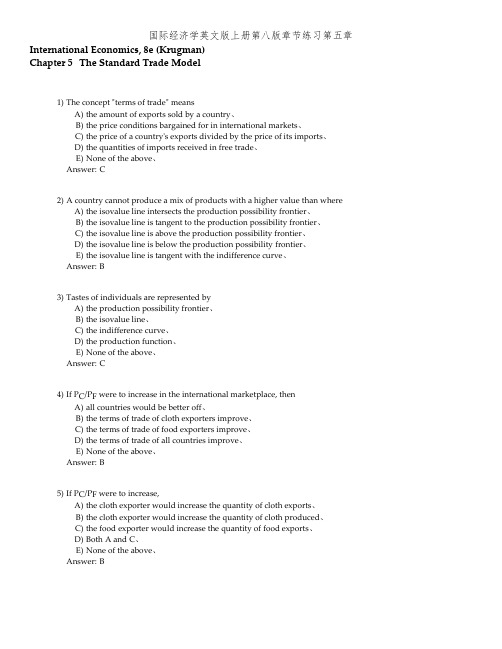
International Economics, 8e (Krugman)Chapter 5 The Standard Trade Model1) The concept "terms of trade" meansA) the amount of exports sold by a country、B) the price conditions bargained for in international markets、C) the price of a country's exports divided by the price of its imports、D) the quantities of imports received in free trade、E) None of the above、Answer: C2) A country cannot produce a mix of products with a higher value than whereA) the isovalue line intersects the production possibility frontier、B) the isovalue line is tangent to the production possibility frontier、C) the isovalue line is above the production possibility frontier、D) the isovalue line is below the production possibility frontier、E) the isovalue line is tangent with the indifference curve、Answer: B3) Tastes of individuals are represented byA) the production possibility frontier、B) the isovalue line、C) the indifference curve、D) the production function、E) None of the above、Answer: C4) If P C/P F were to increase in the international marketplace, thenA) all countries would be better off、B) the terms of trade of cloth exporters improve、C) the terms of trade of food exporters improve、D) the terms of trade of all countries improve、E) None of the above、Answer: B5) If P C/P F were to increase,A) the cloth exporter would increase the quantity of cloth exports、B) the cloth exporter would increase the quantity of cloth produced、C) the food exporter would increase the quantity of food exports、D) Both A and C、E) None of the above、Answer: B6) If a small country were to levy a tariff on its imports then this wouldA) have no effect on that country's economic welfare、B) increase the country's economic welfare、C) decrease the country's economic welfare、D) change the terms of trade、E) None of the above、Answer: C7) Suppose now that Home experiences growth strongly biased toward its export, cloth,A) this will tend to worsen Home's terms of trade、B) this will tend to improve Home's terms of trade、C) this will tend to worsen Foreign's terms of trade、D) this will have no effect on Foreign's terms of trade、E) None of the above、Answer: A8) Suppose that Home is a "small country," and it experiences growth strongly biased toward its export, clothA) this will tend to worsen Home's terms of tradeB) this will tend to improve Home's terms of tradeC) this will tend to worsen Foreign's terms of tradeD) this will have no effect on Foreign's terms of tradeE) None of the aboveAnswer: D9) When the production possibility frontier shifts out relatively more in one direction, we haveA) biased growth、B) unbiased growth、C) immiserizing growth、D) balanced growth、E) imbalanced growth、Answer: D10) Export-biased growth in Country H willA) improve the terms of trade of Country H、B) trigger anti-bias regulations of the WTO、C) worsen the terms of trade of Country F (the trade partner)、D) improve the terms of trade of Country F、E) decrease economic welfare in Country H、Answer: D11) If the poor USAID recipient countries have a higher marginal propensity to consume each and every productthan does the United States, then such aid willA) worsen the U.S. terms of trade、B) improve the U.S. terms of trade、C) leave the world terms of trade unaffected、D) worsen the terms of trade of both donor and recipient countries、E) None of the above、Answer: B12) If, beginning from a free trade equilibrium, the (net barter) terms of trade improve for a country, then it willA) increase production of its import competing good、B) increase consumption of its export good、C) increase the quantity of its imports、D) experience an export-biased shift in its production possibility frontier、E) None of the above、Answer: C13) After WWI, Germany was forced to make large reparations-transfers of real income- to France、If themarginal propensity to consume was equal in both countries, and if France's demand was biased toward food (relative to Germany's demand pattern) then we would expect to findA) the world's relative price for food remains unchanged、B) the world's relative price for food increase、C) the world's relative price for food decrease、D) the world relative price for both food and non-food rise、E) None of the above、Answer: B14) During the 19th Century, economic growth of the major trading countries was biased toward manufacturesand away from food、The less developed countries of that time were net exporters of food、From this information, we would expect to have observedA) falling terms of trade for the less developed countries、B) improving (rising) terms of trade for the less developed countries、C) no change at all in the terms of trade of the less developed countries、D) a decrease in the relative price of food、E) None of the above、Answer: B15) Immiserizing growth could occur toA) a poor country experiencing export-biased economic growth、B) a poor country experiencing import-biased economic growth、C) a poor country experiencing growth in its non-traded sector、D) a poor country experiencing capital-intensive biased growth、E) None of the above、Answer: A16) A large country experiencing import-biased economic growth will tend to experienceA) positive terms of trade、B) deteriorating terms of trade、C) improving terms of trade、D) immiserizing terms of trade、E) None of the above、Answer: C17) If a there are no international loans or capital flows, then if a country's terms of trade improve, we wouldfind thatA) the value of its exports exceeds the value of its imports、B) the value of its exports becomes less than that of its imports、C) the value of its exports exactly equals that of its imports、D) the quantity of its exports equals that of its imports、E) None of the above、Answer: C18) If the U、S、Agency for International Development transfers funds to poor countries in Sub-Saharan Africa,the conventional assumption, following Keynes' analysis would presume that this would tend toA) worsen the U.S. terms of trade、B) improve the U.S. terms of trade、C) worsen the terms of trade of the African aid recipients、D) improve the terms of trade of the African aid recipients、E) None of the above、Answer: A19) If a country's growth is biased in favor of its import, this should unequivocally improve its terms of tradeand its economic welfare、Discuss、Answer: Suppose Japan experiences economic growth biased in favor of its import substitutes、For example, assume that Japan imports components and exports final goods, but that it experiences a major growthin its components manufacture sector、Since Japan is internationally a large country in these markets,this would tend to hurt its component supplier's terms of trade (and help Japan's)、However, such abias in economic growth may tend to lessen the volume of international trade、At an extreme, Japanmay become an exporter of components and an importer of final goods、If the result is a lessening ofspecialization and of the volume of trade, then this effect will lower Japan's welfare associated withgains from trade、If an actual change in the pattern of comparative advantage occurs (a possibility)this may cause dynamic dislocations whose harm overpowers static gains for a relatively long periodof time、20) At the conclusion of World War I, Germany, as a punishment, was obliged to make a large transfer to Francein the form of reparations、Is it possible that the actual reparations may have improved Germany'seconomic welfare?Answer: Such a result is not likely、However, theoretically, if France's income elasticity of demand for Germany's exports was higher than Germany's income elasticity of demand for its own exportable,then the real income transfer associated with these reparations may have improved Germany's termsof trade, and improved its balance of payments, thus helping Germany in manner unanticipated in theTreaty of Verssaille、Explain、21) If the U.S. (a large country) imposes a tariff on its imported good, this will tend toA) have no effect on terms of trade、B) improve the terms of trade of all countries、C) improve the terms of trade of the United States、D) cause a deterioration of U.S. terms of trade、E) raise the world price of the good imported by the United States、Answer: C22) If Slovenia is a small country in world trade terms, then if it imposes a large series of tariffs on many of itsimports, this wouldA) have no effect on its terms of trade、B) improve its terms of trade、C) deteriorate its terms of trade、D) decrease its marginal propensity to consume、E) None of the above、Answer: A23) If Slovenia were a large country in world trade, then if it instituted a large set of subsidies for its exports, thismustA) have no effect on its terms of trade、B) improve its terms of trade、C) deteriorate its terms of trade、D) decrease its marginal propensity to consume、E) None of the above、Answer: C24) If Slovenia were a large country in world trade, then if it instituted a large set of subsidies for its exports, thismustA) cause retaliation on the part of its trade partners、B) harm Slovenia's real income、C) improve Slovenia's real income、D) improve the real income of its trade partners、E) None of the above、Answer: D25) An export subsidy has the opposite effect on terms of trade to the effect of an import tariff、Domestically atariff will raise the price of the import good, deteriorating the domestic terms of trade、A productionsubsidy for the export product will lower the local price of the export good, lowering the domestic terms of trade for the country、Hence the export subsidy and the import tariff have the same effect、This analysis seems to contradict the first sentence in this paragraph、Discuss this paradox、Answer: While this (Lerner) equivalence may well occur domestically, internationally the tariff will improve a country's terms of trade、An export subsidy on the other hand will in fact lower the internationalprice of the (now readily available) export good, hence hurting a country's terms of trade、26) Suppose, as a result of various dynamic factors associated with exposure to international competition,Albania's economy grew, and is now represented by the rightmost production possibility frontier in the figure above、If its point of production with trade was point c, would you consider this growth to beexport-biased or import biased? If Albania were a large country with respect to the world trade of A and B, how would this growth affect Albania's terms of trade? Its real income?Answer: If point c is the production point with trade, then Albania has a comparative advantage in good B、Therefore, from the shape of the new production possibility frontier (as compared to the original one),this is clearly an export-biased growth、This ceteris paribus would tend to worsen Albania's terms oftrade、The terms of trade effect would, again ceteris paribus, worsen its real income、However, thegrowth itself acts in the opposite direction、27) Suppose, as a result of various dynamic factors associated with exposure to international competition,Albania's economy grew, and is now represented by the rightmost production possibility frontier in the figure above、If its point of production with trade was point b, would you consider this growth to beexport-biased or import biased? If Albania were a large country with respect to the world trade of A and B, how would this growth affect Albania's terms of trade? Its real income? What if Albania were a small country?Answer: If the production with trade point was point b, then the observed growth is a case of import-biased growth, and would improve Albania's terms of trade、If Albania were a small country, the world'sterms of trade would not change at all、In such a case, economic growth (with no induced change inincome distributions) would always increase its real income、。
国际经济学课后习题答案
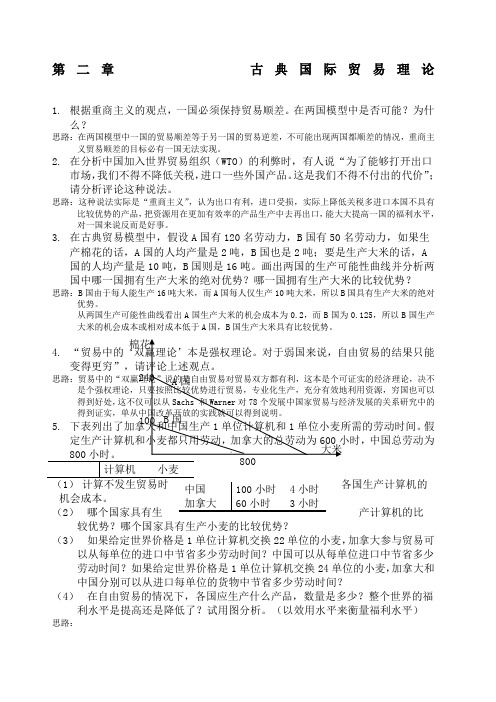
第二章 古典国际贸易理论1. 根据重商主义的观点,一国必须保持贸易顺差。
在两国模型中是否可能?为什么?思路:在两国模型中一国的贸易顺差等于另一国的贸易逆差,不可能出现两国都顺差的情况,重商主义贸易顺差的目标必有一国无法实现。
2. 在分析中国加入世界贸易组织(WTO )的利弊时,有人说“为了能够打开出口市场,我们不得不降低关税,进口一些外国产品。
这是我们不得不付出的代价”;请分析评论这种说法。
思路:这种说法实际是“重商主义”,认为出口有利,进口受损,实际上降低关税多进口本国不具有比较优势的产品,把资源用在更加有效率的产品生产中去再出口,能大大提高一国的福利水平,对一国来说反而是好事。
3. 在古典贸易模型中,假设A 国有120名劳动力,B 国有50名劳动力,如果生产棉花的话,A 国的人均产量是2吨,B 国也是2吨;要是生产大米的话,A 国的人均产量是10吨,B 国则是16吨。
画出两国的生产可能性曲线并分析两国中哪一国拥有生产大米的绝对优势?哪一国拥有生产大米的比较优势? 思路:B 国由于每人能生产16吨大米,而A 国每人仅生产10吨大米,所以B 国具有生产大米的绝对优势。
从两国生产可能性曲线看出A 国生产大米的机会成本为0.2,而B 国为0.125,所以B 国生产大米的机会成本或相对成本低于A 国,B 国生产大米具有比较优势。
4.得到好处,5. 假中国总劳动为各国生产计算机的机会成本。
(2) 哪个国家具有生产计算机的比较优势?哪个国家具有生产小麦的比较优势?(3) 如果给定世界价格是1单位计算机交换22单位的小麦,加拿大参与贸易可以从每单位的进口中节省多少劳动时间?中国可以从每单位进口中节省多少劳动时间?如果给定世界价格是1单位计算机交换24单位的小麦,加拿大和中国分别可以从进口每单位的货物中节省多少劳动时间?(4) 在自由贸易的情况下,各国应生产什么产品,数量是多少?整个世界的福利水平是提高还是降低了?试用图分析。
国际经济学(中文版第八版第五章)
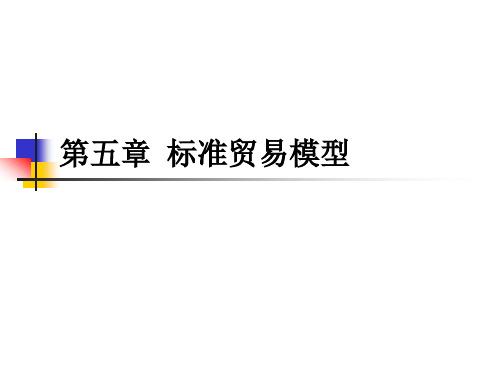
开放经济的标准模型
经济增长和生产可能性边界
经济增长意味着一国的生产可能性边界(TT)
向外移动 偏向型经济增长
当TT向一个方向扩张的幅度大于向另一个方向
扩张的幅度时出现 由两个原因导致:
社会某个生产部门的技术进步 一国某一生产要素的供给增加
RS2 RS1
2 1
RD
棉布的相对
产量 , (a) 偏向于棉布的增长
QC + Q*C QF + Q*F
RD
棉布的相对 产量 , QC + Q*C (b) 偏向于粮食的• 增长 QF + Q*F
开放经济的标准模型
经济增长的国际性影响
其他国家的出口偏向型增长会改善本国的 贸易条件,而其他国家的进口偏向型增长 会恶化本国的贸易条件
TT VV2(PC/PF)2 棉布产量, QC
开放经济的标准模型
相对价格和相对需求
社会消费的价值等于社会生产的价值
PCQC + PFQF = PCDC + PFDF = V
同一条等价值曲线上消费点的选择取 决于社会的消费倾向,可以用一系列 无差异曲线表示社会的消费倾向
开放经济的标准模型
无差异曲线
开放经济的标准模型
粮食产量, QF
图5-6: 偏向型经济增长 粮食产量, QF
TT1 TT2
棉布产量, QC (a)偏向棉布的经济增长
TT1 TT2
棉布产量, QC (b)偏向粮食的经济增长
开放经济的标准模型
相对供给和贸易条件
出口偏向型增长
本国的生产可能性边界的扩张偏向于出口产品 恶化本国的贸易条件,改善其他国家的贸易条件
国际经济学(克鲁格曼)课后习题答案1-8章
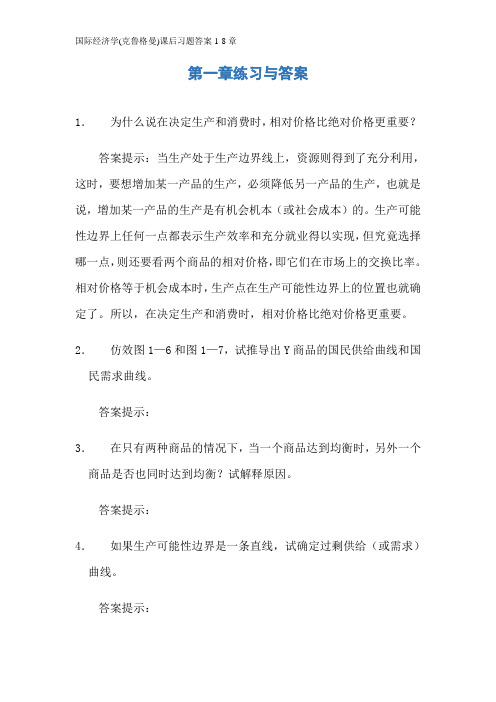
第一章练习与答案1.为什么说在决定生产和消费时,相对价格比绝对价格更重要?答案提示:当生产处于生产边界线上,资源则得到了充分利用,这时,要想增加某一产品的生产,必须降低另一产品的生产,也就是说,增加某一产品的生产是有机会机本(或社会成本)的。
生产可能性边界上任何一点都表示生产效率和充分就业得以实现,但究竟选择哪一点,则还要看两个商品的相对价格,即它们在市场上的交换比率。
相对价格等于机会成本时,生产点在生产可能性边界上的位置也就确定了。
所以,在决定生产和消费时,相对价格比绝对价格更重要。
2.仿效图1—6和图1—7,试推导出Y商品的国民供给曲线和国民需求曲线。
答案提示:3.在只有两种商品的情况下,当一个商品达到均衡时,另外一个商品是否也同时达到均衡?试解释原因。
答案提示:4.如果生产可能性边界是一条直线,试确定过剩供给(或需求)曲线。
答案提示:5.如果改用Y商品的过剩供给曲线(B国)和过剩需求曲线(A 国)来确定国际均衡价格,那么所得出的结果与图1—13中的结果是否一致?答案提示:国际均衡价格将依旧处于贸易前两国相对价格的中间某点。
6.说明贸易条件变化如何影响国际贸易利益在两国间的分配。
答案提示:一国出口产品价格的相对上升意味着此国可以用较少的出口换得较多的进口产品,有利于此国贸易利益的获得,不过,出口价格上升将不利于出口数量的增加,有损于出口国的贸易利益;与此类似,出口商品价格的下降有利于出口商品数量的增加,但是这意味着此国用较多的出口换得较少的进口产品。
对于进口国来讲,贸易条件变化对国际贸易利益的影响是相反的。
7.如果国际贸易发生在一个大国和一个小国之间,那么贸易后,国际相对价格更接近于哪一个国家在封闭下的相对价格水平?答案提示:贸易后,国际相对价格将更接近于大国在封闭下的相对价格水平。
8.根据上一题的答案,你认为哪个国家在国际贸易中福利改善程度更为明显些?答案提示:小国。
9*.为什么说两个部门要素使用比例的不同会导致生产可能性边界曲线向外凸?答案提示:第二章答案1.根据下面两个表中的数据,确定(1)贸易前的相对价格;(2)比较优势型态。
国际经济学课后答案
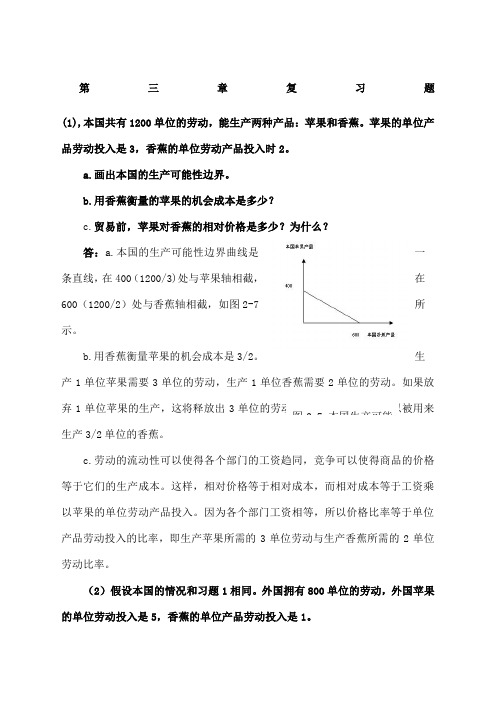
第三章复习题(1),本国共有1200单位的劳动,能生产两种产品:苹果和香蕉。
苹果的单位产品劳动投入是3,香蕉的单位劳动产品投入时2。
a.画出本国的生产可能性边界。
b.用香蕉衡量的苹果的机会成本是多少?c.贸易前,苹果对香蕉的相对价格是多少?为什么?答:a.本国的生产可能性边界曲线是一条直线,在400(1200/3)处与苹果轴相截,在600(1200/2)处与香蕉轴相截,如图2-7所示。
b.用香蕉衡量苹果的机会成本是3/2。
生产1单位苹果需要3单位的劳动,生产1单位香蕉需要2单位的劳动。
如果放弃1单位苹果的生产,这将释放出3单位的劳动。
这2单位的劳动可以被用来图2-7 本国生产可能生产3/2单位的香蕉。
c.劳动的流动性可以使得各个部门的工资趋同,竞争可以使得商品的价格等于它们的生产成本。
这样,相对价格等于相对成本,而相对成本等于工资乘以苹果的单位劳动产品投入。
因为各个部门工资相等,所以价格比率等于单位产品劳动投入的比率,即生产苹果所需的3单位劳动与生产香蕉所需的2单位劳动比率。
(2)假设本国的情况和习题1相同。
外国拥有800单位的劳动,外国苹果的单位劳动投入是5,香蕉的单位产品劳动投入是1。
a.画出外国的生产可能性边界。
b.画出世界相对供给曲线。
答:a.外国的生产可能性边界曲线是一条直线,在160(800/5)处与苹果轴相截,在800(800/1)处与香蕉轴相截。
如图2-8所示。
b.世界相对供给曲线可以由苹果和香蕉的相对价格和相对供给量绘出。
如图2-9。
从图2-9可以看出,苹果对香蕉的最低相对价格是3/2,在这个价格上,苹果的世界相对供给曲线是水平的。
在3/2的相对价格上,本国对苹果的最大供给量是400,外国对香蕉的供给量是800,这时,相对供给量为1/2。
只要相对价格保持在3/2和5之间,相对供给量就不变。
如果相对价格成为5,两个国家都会生产苹果,香蕉的产量为零。
这时,相对供给曲线是水平的。
所以,从图2-9中可以看出,相对价格为3/2时,相对供给在0到1/2之间;相对价格在3/2和5之间时,相对供给保持1//2不变;当相对价格为5时,相对供给从1/2图2-9 世界相对供图2-8 外国生产可能曲到无穷大。
克鲁格曼《国际经济学》(第8版)课后习题详解
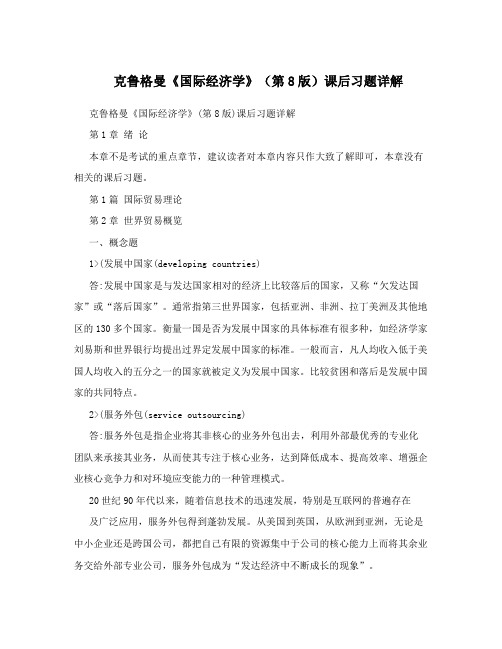
克鲁格曼《国际经济学》(第8版)课后习题详解克鲁格曼《国际经济学》(第8版)课后习题详解第1章绪论本章不是考试的重点章节,建议读者对本章内容只作大致了解即可,本章没有相关的课后习题。
第1篇国际贸易理论第2章世界贸易概览一、概念题1>(发展中国家(developing countries)答:发展中国家是与发达国家相对的经济上比较落后的国家,又称“欠发达国家”或“落后国家”。
通常指第三世界国家,包括亚洲、非洲、拉丁美洲及其他地区的130多个国家。
衡量一国是否为发展中国家的具体标准有很多种,如经济学家刘易斯和世界银行均提出过界定发展中国家的标准。
一般而言,凡人均收入低于美国人均收入的五分之一的国家就被定义为发展中国家。
比较贫困和落后是发展中国家的共同特点。
2>(服务外包(service outsourcing)答:服务外包是指企业将其非核心的业务外包出去,利用外部最优秀的专业化团队来承接其业务,从而使其专注于核心业务,达到降低成本、提高效率、增强企业核心竞争力和对环境应变能力的一种管理模式。
20世纪90年代以来,随着信息技术的迅速发展,特别是互联网的普遍存在及广泛应用,服务外包得到蓬勃发展。
从美国到英国,从欧洲到亚洲,无论是中小企业还是跨国公司,都把自己有限的资源集中于公司的核心能力上而将其余业务交给外部专业公司,服务外包成为“发达经济中不断成长的现象”。
3>(引力模型(gravity model)答:丁伯根和波伊赫能的引力模型基本表达式为:其中,是国与国的贸易额,为常量,是国的国内生产总值,是国的国内生产总值,是两国的距离。
、、三个参数是用来拟合实际的经济数据。
引力模型方程式表明:其他条件不变的情况下,两国间的贸易规模与两国的GDP成正比,与两国间的距离成反比。
把整个世界贸易看成整体,可利用引力模型来预测任意两国之间的贸易规模。
另外,引力模型也可以用来明确国际贸易中的异常现象。
4>(第三世界(third world)答:第三世界这个名词原本是指法国大革命中的Third Estate(第三阶级)。
克鲁格曼《国际经济学》第8版笔记和课后习题详解(标准贸易模型)【圣才出品】

克鲁格曼《国际经济学》第8版笔记和课后习题详解第5章标准贸易模型5.1复习笔记1.开放经济的标准模型标准贸易模型建立在四个重要关系的基础之上:生产可能性边界和相对供给曲线之间的关系;相对价格和相对需求之间的关系;贸易条件(一个国家出口产品的价格除以进口产品的价格)对国家福利的影响;确定世界均衡的世界相对供给与相对需求之间的关系。
以下将逐一进行介绍。
(1)生产可能性边界和相对供给如图5-1所示,曲线TT 为一国的生产可能性边界。
点Q 是生产点,位于生产可能性边界所能接触到的最高的一条等价值线上。
图5-1产品相对价格确定社会产出可以在图5-1上用一系列等价值线来表示市场的产出价值,离原点越远的等价值线对应的产出价值就越高。
假定/C F P P 上升,则等价值线会变陡。
如图5-2所示,当棉布的相对价格从()1/C F P P 上升到()2/C F P P (从1VV 移动到2VV )时,等价值线变陡。
这时,社会将生产更多的棉布和更少的粮食,均衡产出点将从点1Q 移动到点2Q 。
图5-2棉布相对价格的上升如何影响相对供给(2)相对价格和相对需求如图5-3所示,点Q 是生产点,点D 是消费点。
该国生产的棉布比消费的棉布多,因而出口棉布;相应的,消费的粮食比生产的粮食多,因而进口粮食。
图5-3标准模型中的生产、消费和贸易图5-4说明了相对价格/C F P P 上升所产生的影响。
当相对价格/C F P P 上升时,所有的等价值曲线变得更陡,最大价值线会从1VV 移到2VV ;生产点会从点1Q 移动到点2Q ;消费点会从点1D 移动到点2D 。
图5-4棉布相对价格上升产生的影响从点1D 到点2D 的移动反映了/C F P P 上升所产生的两个影响:①消费移动到了一条更高的无差异曲线上,社会福利改善了——收入效应。
②相对价格的变动会使得消费点随无差异曲线向靠近粮食、背离棉布的方向移动——替代效应。
(3)贸易条件改变对福利的影响贸易条件对国家福利的影响可以在图5-4中得到说明。
国际经济学课后习题及答案(2)

第一章国际贸易理论的微观基础1.为什么说在决定生产和消费时,相对价格比绝对价格更重要?答案提示:当生产处于生产边界线上,资源则得到了充分利用,这时,要想增加某一产品的生产,必须降低另一产品的生产,也就是说,增加某一产品的生产是有机会机本(或社会成本)的。
生产可能性边界上任何一点都表示生产效率和充分就业得以实现,但究竟选择哪一点,则还要看两个商品的相对价格,即它们在市场上的交换比率。
相对价格等于机会成本时,生产点在生产可能性边界上的位置也就确定了。
所以,在决定生产和消费时,相对价格比绝对价格更重要。
2.仿效图1—6和图1—7,试推导出Y商品的国民供给曲线和国民需求曲线。
答案提示:参照教材中第一章第二节(第26页)的内容,将图1-6(a)中,以横坐标表示Y商品的供给,以纵坐标表示X商品供给,得出相应的生产可能性曲线;然后将图1-6(b)中,以横坐标表示Y商品的供给,以纵坐标表示Y的相对价格P Y/P X,通过类似推导可得出国民供给曲线,国民需求曲线做类似推导即可求出。
3.在只有两种商品的情况下,当一个商品达到均衡时,另外一个商品是否也同时达到均衡?试解释原因。
答案提示:两种商品同时达到均衡。
当一种商品达到均衡时,该商品的相对价格、均衡供给与需求、均衡状态下对生产要素的需求与供给都得以确定,则可得到另一种商品的相对价格、生产要素需求,从而确定该商品的均衡状态下供给和需求。
4.如果生产可能性边界是一条直线,试确定过剩供给(或需求)曲线。
答案提示:参照教材图1-12、图1-13国民供给曲线与国民需求曲线的推导;过剩供给(或需求)曲线的形状,参见教材第30页。
5.如果改用Y商品的过剩供给曲线(B国)和过剩需求曲线(A国)来确定国际均衡价格,那么所得出的结果与图1—13中的结果是否一致?答案提示:相一致。
国际均衡价格将依旧处于贸易前两国相对价格的中间某点。
6.说明贸易条件变化如何影响国际贸易利益在两国间的分配。
国际经济学第五章___标准贸易模型

第五章标准贸易模型第一节开放经济的标准模型一、对以前模型的概述前面已经分析介绍了三个不同的模型。
每一个模型对生产可能性的决定因素都作了不同的假设。
为了突出重点,每一个模型都略去了其他模型强调的现实中的一些方面。
这些模型有:1.李嘉图模型。
生产可能性由单一要素(劳动)在两个部门的分配情况所决定。
该模型阐述的实质观点是比较优势,但无法让我们对收入的分配进行讨论。
2.特定要素模型。
当劳动可以在不同的部门之间自由流动时,其他的要素对于具体的产业而言都是特定的。
对于理解收入分配来说,这是个理想的模型,但难以用来讨论贸易模式。
3.赫克歇尔—俄林模型。
生产中的多种要素可以在部门之间自由移动。
该模型比前两个模型都难以掌握,但对于资源是如何决定贸易模式有一个更深的理解。
在分析实际问题时,我们要将结论建立在所有模型综合的基础上。
例如;20世纪80年代国际贸易的主要变动是日本,韩国和台湾的出口迅猛增长。
这些国家或地区都经历了劳动生产率的迅速发展。
要讨论劳动生产率增长所产生的影响,我们可以应用第2章的李嘉图模型。
贸易模式的变动对美国的不同集团有不同的影响。
要理解环太平洋贸易的增长对美国收入分配的影响,我们需要应用第3章的特定要素模型。
最后,经过一段时期的发展,新兴工业化国家的资源结构已经发生了变化。
由于它们积聚资本,提高劳动力的受教育水平,从而使非技术工人变成了稀缺要素。
为了理解这一变动产生的影响,我们要转向赫克歇尔一俄林模型。
尽管这些模型有许多具体区别,但都有着以下几个共同特点:l.社会的生产能力可以用生产可能性边界来表示,生产可能性边界的不同导致了贸易的产生。
2.生产可能性边界确定了一个国家或地区的相对供给曲线。
3.世界相对需求曲线和位于各国相对供给曲线之间的世界相对供给曲线确定了世界均衡点。
由于这些共同特点,我们可以将已经研究过的模型看成是一个更具一般性的世界贸易模型的特例。
这个一般性模型可用于分析国际经济学中的一些重要课题。
克鲁格曼《国际经济学》(第8版)课后习题详解(第5章 标准贸易模型)【圣才出品】
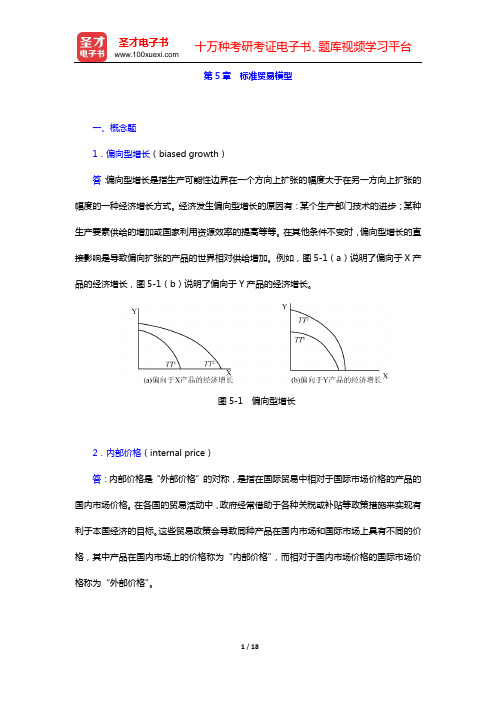
第5章标准贸易模型一、概念题1.偏向型增长(biased growth)答:偏向型增长是指生产可能性边界在一个方向上扩张的幅度大于在另一方向上扩张的幅度的一种经济增长方式。
经济发生偏向型增长的原因有:某个生产部门技术的进步;某种生产要素供给的增加或国家利用资源效率的提高等等。
在其他条件不变时,偏向型增长的直接影响是导致偏向扩张的产品的世界相对供给增加。
例如,图5-1(a)说明了偏向于X产品的经济增长,图5-1(b)说明了偏向于Y产品的经济增长。
图5-1 偏向型增长2.内部价格(internal price)答:内部价格是“外部价格”的对称,是指在国际贸易中相对于国际市场价格的产品的国内市场价格。
在各国的贸易活动中,政府经常借助于各种关税或补贴等政策措施来实现有利于本国经济的目标。
这些贸易政策会导致同种产品在国内市场和国际市场上具有不同的价格,其中产品在国内市场上的价格称为“内部价格”,而相对于国内市场价格的国际市场价格称为“外部价格”。
3.出口偏向型增长(export-biased growth)答:出口偏向型增长是指一国的经济增长主要源于出口产品生产能力提高的增长方式,表现在生产可能性边界上就是使生产可能性边界扩张偏向于出口产品。
一国的经济增长意味着该国生产能力的提高,从而使该国能够生产更多的产品。
对于不同产品而言,其生产能力的提高幅度可能是不相同的。
如果一国出口产品生产能力的提高幅度超过了其他类产品,那么这种经济增长方式就是出口偏向型增长。
4.等价值线(iso value lines)答:等价值线是描述市场产出价值的曲线,同一条等价值线的产出价值相等且不变。
例如,如图5-2所示,有两种产品A和B,价格分别是A P和B P,产量是A Q和B Q,那么等价值线是由等式A A B B+=所确定的。
V越大,等价值线的位置离原点越远,对应的产P Q P Q V出价值就越高。
图5-2 等价值线5.出口补贴(export subsidy)答:出口补贴是指国家为了降低出口商品的价格,提高其在国际市场上的竞争能力,对出口商品给予的现金补贴或财政上的优惠待遇。
国际经济学部分答案(详细解答过程)
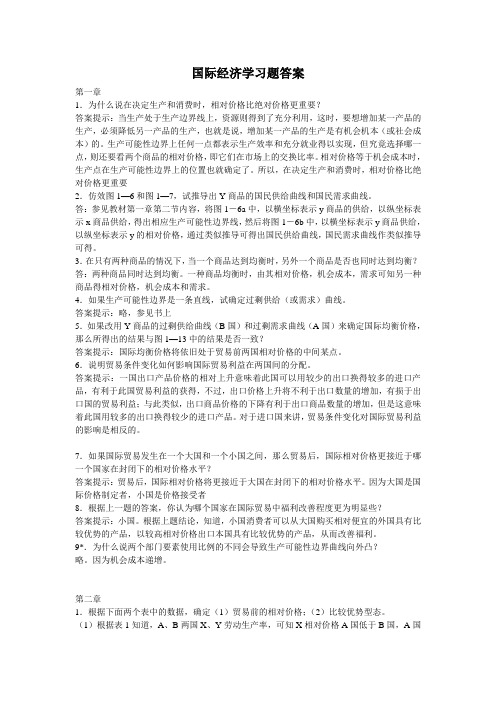
国际经济学习题答案第一章1.为什么说在决定生产和消费时,相对价格比绝对价格更重要?答案提示:当生产处于生产边界线上,资源则得到了充分利用,这时,要想增加某一产品的生产,必须降低另一产品的生产,也就是说,增加某一产品的生产是有机会机本(或社会成本)的。
生产可能性边界上任何一点都表示生产效率和充分就业得以实现,但究竟选择哪一点,则还要看两个商品的相对价格,即它们在市场上的交换比率。
相对价格等于机会成本时,生产点在生产可能性边界上的位置也就确定了。
所以,在决定生产和消费时,相对价格比绝对价格更重要2.仿效图1—6和图1—7,试推导出Y商品的国民供给曲线和国民需求曲线。
答:参见教材第一章第二节内容,将图1-6a中,以横坐标表示y商品的供给,以纵坐标表示x商品供给,得出相应生产可能性边界线,然后将图1-6b中,以横坐标表示y商品供给,以纵坐标表示y的相对价格,通过类似推导可得出国民供给曲线,国民需求曲线作类似推导可得。
3.在只有两种商品的情况下,当一个商品达到均衡时,另外一个商品是否也同时达到均衡?答:两种商品同时达到均衡。
一种商品均衡时,由其相对价格,机会成本,需求可知另一种商品得相对价格,机会成本和需求。
4.如果生产可能性边界是一条直线,试确定过剩供给(或需求)曲线。
答案提示:略,参见书上5.如果改用Y商品的过剩供给曲线(B国)和过剩需求曲线(A国)来确定国际均衡价格,那么所得出的结果与图1—13中的结果是否一致?答案提示:国际均衡价格将依旧处于贸易前两国相对价格的中间某点。
6.说明贸易条件变化如何影响国际贸易利益在两国间的分配。
答案提示:一国出口产品价格的相对上升意味着此国可以用较少的出口换得较多的进口产品,有利于此国贸易利益的获得,不过,出口价格上升将不利于出口数量的增加,有损于出口国的贸易利益;与此类似,出口商品价格的下降有利于出口商品数量的增加,但是这意味着此国用较多的出口换得较少的进口产品。
国际经济学英文版上册第八版章节练习第五章
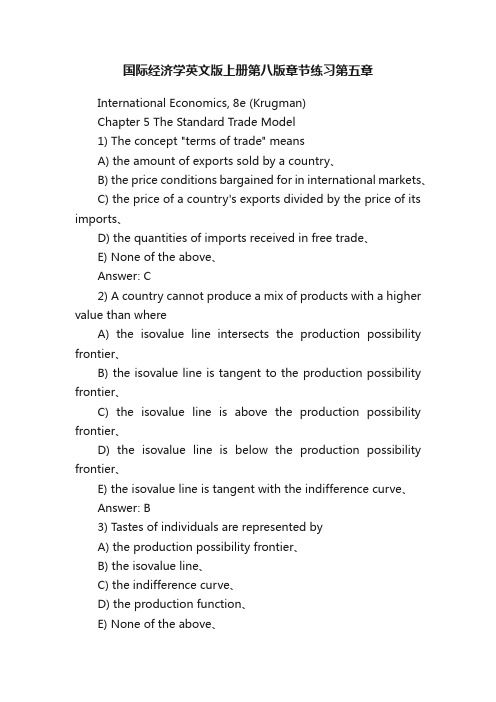
国际经济学英文版上册第八版章节练习第五章International Economics, 8e (Krugman)Chapter 5 The Standard Trade Model1) The concept "terms of trade" meansA) the amount of exports sold by a country、B) the price conditions bargained for in international markets、C) the price of a country's exports divided by the price of its imports、D) the quantities of imports received in free trade、E) None of the above、Answer: C2) A country cannot produce a mix of products with a higher value than whereA) the isovalue line intersects the production possibility frontier、B) the isovalue line is tangent to the production possibility frontier、C) the isovalue line is above the production possibility frontier、D) the isovalue line is below the production possibility frontier、E) the isovalue line is tangent with the indifference curve、Answer: B3) Tastes of individuals are represented byA) the production possibility frontier、B) the isovalue line、C) the indifference curve、D) the production function、E) None of the above、Answer: C4) If P C/P F were to increase in the international marketplace, thenA) all countries would be better off、B) the terms of trade of cloth exporters improve、C) the terms of trade of food exporters improve、D) the terms of trade of all countries improve、E) None of the above、Answer: B5) If P C/P F were to increase,A) the cloth exporter would increase the quantity of cloth exports、B) the cloth exporter would increase the quantity of cloth produced、C) the food exporter would increase the quantity of food exports、D) Both A and C、E) None of the above、Answer: B6) If a small country were to levy a tariff on its imports then this wouldA) have no effect on that country's economic welfare、B) increase the country's economic welfare、C) decrease the country's economic welfare、D) change the terms of trade、E) None of the above、Answer: C7) Suppose now that Home experiences growth strongly biased toward its export, cloth,A) this will tend to worsen Home's terms of trade、B) this will tend to improve Home's terms of trade、C) this will tend to worsen Foreign's terms of trade、D) this will have no effect on Foreign's terms of trade、E) None of the above、Answer: A8) Suppose that Home is a "small country," and it experiences growth strongly biased toward its export, clothA) this will tend to worsen Home's terms of tradeB) this will tend to improve Home's terms of tradeC) this will tend to worsen Foreign's terms of tradeD) this will have no effect on Foreign's terms of tradeE) None of the aboveAnswer: D9) When the production possibility frontier shifts out relatively more in one direction, we haveA) biased growth、B) unbiased growth、C) immiserizing growth、D) balanced growth、E) imbalanced growth、Answer: D10) Export-biased growth in Country H willA) improve the terms of trade of Country H、B) trigger anti-bias regulations of the WTO、C) worsen the terms of trade of Country F (the trade partner)、D) improve the terms of trade of Country F、E) decrease economic welfare in Country H、Answer: D11) If the poor USAID recipient countries have a higher marginal propensity to consume each and every productthan does the United States, then such aid willA) worsen the U.S. terms of trade、B) improve the U.S. terms of trade、C) leave the world terms of trade unaffected、D) worsen the terms of trade of both donor and recipient countries、E) None of the above、Answer: B12) If, beginning from a free trade equilibrium, the (net barter) terms of trade improve for a country, then it willA) increase production of its import competing good、B) increase consumption of its export good、C) increase the quantity of its imports、D) experience an export-biased shift in its production possibility frontier、E) None of the above、Answer: C13) After WWI, Germany was forced to make large reparations-transfers of real income- to France、If the marginal propensity to consume was equal in both countries, and if France's demand was biased toward food (relative to Germany's demand pattern) then we would expect to findA) the world's relative price for food remains unchanged、B) the world's relative price for food increase、C) the world's relative price for food decrease、D) the world relative price for both food and non-food rise、E) None of the above、Answer: B14) During the 19th Century, economic growth of the major trading countries was biased toward manufacturesand away from food、The less developed countries of that time were net exporters of food、From this information, we would expect to have observedA) falling terms of trade for the less developed countries、B) improving (rising) terms of trade for the less developed countries、C) no change at all in the terms of trade of the less developed countries、D) a decrease in the relative price of food、E) None of the above、Answer: B15) Immiserizing growth could occur toA) a poor country experiencing export-biased economic growth、B) a poor country experiencing import-biased economic growth、C) a poor country experiencing growth in its non-traded sector、D) a poor country experiencing capital-intensive biased growth、E) None of the above、Answer: A。
- 1、下载文档前请自行甄别文档内容的完整性,平台不提供额外的编辑、内容补充、找答案等附加服务。
- 2、"仅部分预览"的文档,不可在线预览部分如存在完整性等问题,可反馈申请退款(可完整预览的文档不适用该条件!)。
- 3、如文档侵犯您的权益,请联系客服反馈,我们会尽快为您处理(人工客服工作时间:9:00-18:30)。
第五章 标准贸易模型
1、
答:如图,贸易后,两国原先的无差异曲线都移动到了更高的无差异曲线上,两国人民都更幸福,社会福利增加。
2、
答:(a )如左图,假如过度捕鱼引起的鱼产量大幅度减少,则挪威的生产可能性边界发生变化,导致等价值线向下移动,相应的无差异曲线移动到了较低的水平上,导致福利下降。
(b )如右图,当过度捕鱼引起鱼的产量减少,在市场上鱼的供给减少,导致相对价格上升,上升到一定程度不仅可以弥补鱼的产量损失,甚至会带来福利的上升。
3、
答:如图,以粮食和棉布为例,当生产可能性边界是直角时,贸易条件改善增进了本国福利。
生产点位于直角顶点,消费点是等价值线和无差异曲线的切点。
贸易条件的改善使得等价值线的截距增加,即等价值线直角顶点向外偏转(由于没有流动要素,生产点固定)。
经济体达鱼 车 鱼
车
瑞典 F C
本国
鱼 车 鱼
车
挪威 挪威
挪威
到获得了更高的无差异曲线,从直观上来看,产出并没有发生变化,经济体获益主要是通过相对于进口产品购买力的增加来实现的。
4、
答:由于购买产品比例是固定的,所以无差异曲线是直角形状。
贸易条件的改善使该国达到了更高的无差异曲线。
无差异曲线沿着从原点出发的射线移动,其顶点始终在该射线上,射线的斜率为两种产品的比例,贸易条件的改善使无差异曲线远离原点。
5、答:日本贸易条件是制造品价格比去原材料价格的相对价格,贸易条件的变动由相对供给和相对需求的变动决定。
(a )中东石油供应的紧缺使得原材料的供给减少,这导致了制造品的相对供给增加,RS 曲线向右移动,制造品的相对价格下降,日本的贸易条件恶化。
(b )韩国扩展了汽车生产能力增加了世界汽车的总供给,使得世界汽车的相对供给增加了,RS 曲线向右移动,世界市场上汽车的相对价格下降了,日本的贸易条件恶化了。
(c )美国工程师以核反应堆代替石油燃料发电厂,减少了对石油,即原材料的需求,这导致了原材料相对价格的下降,RD 曲线向右移动,制造品的相对需求上升和相对价格上升,日本的贸易条件得以改善。
由于原材料的需求下降了,即使核反应堆没有建在日本,这种情况仍会发生。
(d )俄罗斯农业歉收减少了世界原材料的总供给,使得世界制造品的相对供给增加,RS 曲线向外移动;与此同时,俄罗斯对制造品的需求减少了,使得世界相对需求减少了,RD 曲线向内移动。
日本的贸易条件恶化了。
(e )降低关税是国内制造品相对价格上升了,增加了国内制造品的相对供给,减少了相对需求;与此同时,增加了世界制造品的相对供给并减少了世界相对需求。
世界RS 曲线向外移动,RD 曲线向内移动,制造品的世界相对价格下降了,日本的贸易条恶化了。
6、
s M USA
F C
答:如图,可出口性服务的相对价格下降导致等价值线顺时针旋转,导致美国将生产更少的服务和更多的制造品,所以无差异曲线移动到了较低的程度上,降低了福利。
7、答:当一种生产要素增加时,会发生偏向型增长。
资本存量的增加使X产品的产出相对增加,而劳动力的增加使Y产品的产出相对增加。
在赫克歇尔—俄林模型中,各国倾向于出口密集使用本国相对充裕要素的产品。
出口偏向型增长所带来的贸易条件恶化是否会成为福利恶化型增长,没有明确的结论。
进口偏向型增长带来的贸易条件的改善的确实会使得异国福利增加。
(a)A国的贸易条恶化,福利仍会改善,但在极端条件下可能恶化;B国的贸易条件及福利都改善了。
(b)A国的贸易条件及福利都改善了;B国的贸易条件和福利都恶化了。
(c)B国的贸易条件及福利都改善了;A国的贸易条件及福利都恶化了。
(d)B国的贸易条恶化,福利仍会改善,但在极端条件下可能恶化;A国的贸易条件及福利都改善了
8、答:福利恶化型增长的条件非常极端:RS和RD曲线必须非常陡峭,经济增长对出口产品的偏向非常强,该经济体在世界经济中的比重必须大到足以令其出口偏向型增长使其贸易条件大幅度恶化,以至于贸易条件的恶化足以抵消生产能力的提高所带来正面效应。
因此这种增长在现实中是不太可能存在的。
9.答:印度的开放有利于美国,如果它降低了中国出口到美国商品的相对价格,因此就提高了美国出口商品的相对价格。
虽然美国本土被与中国的贸易损害的部门会同样被与印度的贸易损害,但总体上来说,美国是获利的。
印度与中国出口的商品具有一定相似性,其加入与美贸易,会使得对美出口商品的总供给量增加,从而压低中国对美出口的商品的相对价格,导致中国福利损失。
10、答:这种援助条件对于收入转移问题的分析没有太大影响,从援助国角度来看该条件有一定现实意义。
必须购买援助国出口品的援助增加了援助国出口品的相对需求,使其相对价格上升,在该种情况下,受援国的贸易条件恶化了。
受援国福利条件恶化是转移支付的一种极端的情况,和福利恶化型增长一样,转移支付恶化受援国福利只是一种理论上的可能。
11、答:假设有两个国家,A国和B国,如果A国对出口产品进行补贴,那么其出口的相对供给就会上升,而相对需求就会下降,贸易条件就会恶化,B国针锋相对的关税加剧了A贸易条件的恶化。
A国遭受了贸易条件恶化及国内市场价格扭曲的双重损失;B国既享受了A 国的贸易补贴,又获得了关税收益,使其贸易条件得到了双重改善。
如果B国也进行出口补贴,那么这将会抵消A国贸易补贴给B国带来的贸易条件的改善,从而在一定程度上改善了A国原本恶化的贸易条件,恶化了B国原本改善的贸易条件。
